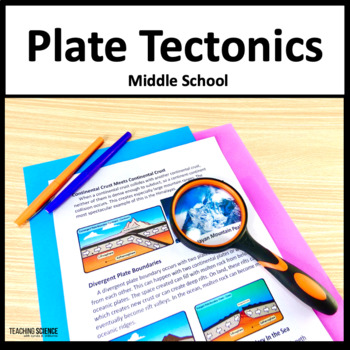Plate Tectonics for Middle School Science
Plate tectonics is a theory explaining the structure of the earth's crust and many associated phenomena as resulting from the interaction of rigid lithospheric plates which move slowly over the underlying mantle.
Students need engaging experiences with science! Students in 6th through 8th grade really benefit from having engaging labs, high-quality nonfiction text to read, and clever interactive notebook flaps and folds. Recently I was asked how I plan science for older kids. So, here I will share my process.
I was looking at the following science standards for NGSS
MS-ESS2-2. Construct an explanation based
on evidence for how geoscience processes have changed Earth’s surface at
varying time and spatial scales.
MS-ESS2-3.
Analyze and interpret data on the
distribution of fossils and rocks, continental shapes, and seafloor
structures to provide evidence of the past plate motions
I found similar standards for Utah SEEd.
Utah SEEd
Standard 7.2.5
Ask questions and analyze and interpret
data about the patterns between plate tectonics and:
(1)The occurrence of earthquakes and volcanoes.
(2)
Continental and ocean floor features.
(3)
The distribution of rocks and fossils.
Standard 7.2.2 Construct an explanation
based on evidence for how processes have changed Earth’s surface at varying
time and spatial scales. Examples of processes that occur at varying time
scales could include slow plate motions or rapid landslides. Examples of
processes that occur at varying spatial scales could include uplift of a
mountain range or deposition of fine sediments.
When I saw these I thought there has got to be a way to make this more engaging, integrate some literacy and language arts and involve the students in critical thinking.
I thought to myself, what are the science concepts related to these standards:
- Science Concepts Addressed Include:
- Layers of the Earth
- Plate Tectonics
- Plate Boundaries
- Divergent Boundaries
- Convergent Boundaries
- Transform Boundaries
- Mid Ocean Ridges
- Seafloor spreading
- Subduction
- The Continental Margin
- Constructing and Explanation Based on Evidence
- Research
- Making Inferences
- Looking at Fossil Evidence
- Making an Argument from Evidence
- Continent and Ocean Floor Features
I developed some nonfiction passages and aligned it with a CLOSE reading strategy.
I developed some response pages with text-dependent questions and some clever interactive notebook inserts.
I then put these together with some other meaningful activities like QR code Research and writing activities that align with CCSS for Reading informational text and Writing.
Here are two of the resources I have put together. The first one is a large unit on Plate Tectonics.
This unit aligns with NGSS MS-ESS2-2 and MS-ESS2-3 and Utah SEEd 7.2.2 and 7.2.5 The other one that I think aligns well with these standards is
The other one that I think aligns well with these standards is
Thank you for visiting. Middle-school-students need engaging materials and experiences too!
Please share this post on social media!
Please share this post on social media!








